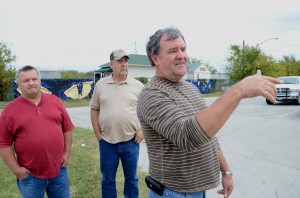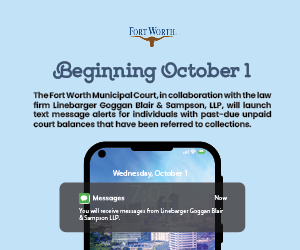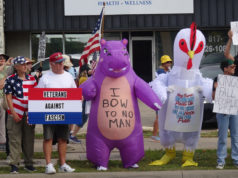A few years ago, Robert Morris started having nightmares about his time at Technicoat. He dreamed about the vast pits in which he used to dump chemical waste, creating a toxic stew that he and his co-workers would then cover over with dirt.

“I was looking at this big, black, murky pit and thinking, ‘You don’t want to get in that stuff, it’ll kill you,’” he said.
Those dreams may come uncomfortably close to the truth. Around the time he started having the recurring nightmares, he also began feeling ill. For the last several years, his health has spiraled downward. He suffers from a staggering number of ailments that, according to his physician, Kapil Sharma of the University of Texas Southwest Medical Center at Dallas, may all be related to his tenure at Technicoat. Fort Worth Weekly was unable to contact Dr. Sharma for this story.
Morris was diagnosed in 2011 with peripheral neuropathy — that is, damage to the nervous system outside the brain and spinal cord. Various studies, including a 2007 U.S. Department of Health and Human Services report, have linked the disorder to the carcinogenic solvent trichlorethylene. The Environmental Protection Agency found large amounts of the chemical in its 1999 study of the soil and water at the old plant site.
The chemical compound also causes liver and kidney damage. Morris has holes in his liver and one of his kidneys that doctors attribute to the corrosive chemicals. The organs, one doctor told him, will eventually fail.
His toxicologist told him that he has so much barium in his blood, Morris said, that he is in the top 17 percent of people who have tested positive for it. Barium is considered poisonous at high levels and has been known to cause everything from anxiety to paralysis.
The various reports on the contaminated soil from the Technicoat site read like a diary of Morris’ work there from 1973 to ’78.
Take trichlorethylene. Morris remem-bers occasions when his former manager’s actions narrowly kept the chemical from asphyxiating workers.
“There were a few times [when] the plant manager John Renfrow would run past me like a crazed Indian yelling, ‘Get down, get down,’” Morris said. “I’d turn around and look and see steam pouring out over [the top of] this trichlorethylene tank, and he was crawling on his hands and knees through mud and stuff to turn on this cold water faucet that you’re supposed to run at all times when you’re using this tank. Stuff would boil out of there like a big vapor.”
Had Renfrow not have turned the cold water on, “it would have asphyxiated everybody,” Morris said.
“You’d have a real bad ‘drunk’ headache for 30 to 40 minutes” after the boil-over, he said. “I would be 15 or 20 feet away from the vat at those times.”
He recalled using the solvent methylethylketone, or MEK, for up to three times longer than OSHA standards permitted.
“We would work with MEK … to clean [airplane] parts in five-gallon buckets, for two to three hours at a time, six days a week,” he said. “So in a work day you would probably work with MEK for six to eight hours depending on your work shift.”
The chemical base sodium hydroxide, or caustic soda, aroused particularly strong emotions in Morris.
“This was the chemical we used to etch highway signs for the [Texas] Transportation Department,” he said. “The fumes and ash would settle on anything close by. We would look as though we had aged — our hair would turn white with residue. And when you would wash it out, it would smell of rotten eggs.”
The same story goes for many of the other dozens of chemicals the EPA found on or near the site. Morris remembers how he came into contact with them. And he now worries about what those chemicals are doing to his health.
********
The two-acre Technicoat property is part of a larger parcel whose industrial use dates back to World War II. In 1943, the Defense Plant Corporation built a factory there at the request of the U.S. government to manufacture chemical catalysts used in bombs.
American Cyanamid bought the plant in 1946 and sold one of the property’s two factories to Jean Smyers, who started Southern Anodizing in the early 1960s. Smyers sold the coatings plan to Felton Havins Sr. in 1971, and he continued to operate the facility as Technicoat until April 1990. The city bought the land from Technicoat in November 2001.
Throughout the coating plant’s 40 years of operation, it drew complaints about pollution.
The Texas Water Commission began monitoring the site in 1970. In 1991 it levied the $158,880 fine against Technicoat for multiple violations of Texas’ environmental standards. A 1991 document notes that high levels of several dangerous chemicals were detected there, including cadmium and chromium, carcinogens linked to breast, lung, and prostate cancers.
TCEQ created an action plan to clean up the property in the early ’90s. All of the property’s subsequent owners have been saddled with the responsibility of continuing that cleanup and monitoring the pollution levels of surrounding soil and water.
When the city bought the property, terms of the sale included a requirement that the city pay off the remaining $45,000 of the Technicoat fine.
The city entered the site into TCEQ’s voluntary cleanup program, with the goal of making the surrounding areas safe for residential use. The Technicoat site itself cannot be redeveloped.
The city hired a company to remove 40,000 cubic yards of contaminated soil as well as underground tanks. Price tag for the “dig and haul” work: more than $3 million. Water wells on the property were also plugged, except for two used for testing, since TCEQ had ruled any groundwater below the site was unusable.
Once the rubber mat was installed to cover the soil and the site was paved, TCEQ deemed it safe.
In 2007 the site was sold to Fort Worth Cats former owner Carl Bell. TCEQ continued to monitor the site and take soil and water samples. Three years later, Bell sold 42 acres to the Tarrant Regional Water District, including the old Technicoat site.
When the district ratcheted up work on the Trinity River Vision project in 2011, further cleanup of the Technicoat site was its first major environmental chore. The state required the water district to remove remaining chromium and chlorinated solvent pollutants. The water district still is required to monitor the surrounding soil and water for contaminants.
Frossard said samples show that there are still trace amounts of chemicals on and around the site. But levels are now low enough that TCEQ is satisfied that “natural attenuation” will take care of the problem.
“The chemical levels are so low that they will naturally go away,” he said. “They are not of a level that the state was concerned.
“Removing the aboveground tanks and belowground storage removed the source,” he said. “Once they did the digging around the area, it removed most of the remaining material that was left that could migrate.”
By TCEQ standards, the Technicoat/ American Cyanamid site is no longer an environmental threat, as long as it remains a parking lot and is never again disturbed.
********












Eric,
I would like to say, Thank you from my father and mother. I would also like to say thank you from my brothers Joe and Gary. And most of all I would like to say thank you! I hope all who reads this story of Fort Worth’s past and still present hazardous chemical site. I understand that the EPA states the site is safe. But there are us the victims of the negligence of a company whose only concern was their prosperity.
Robert Morris
I was doing a search on sick people around this area because of my own neuromuscular disease which is very rare and I found this article. I have been sick many years now and I was raised in White Settlement playing in a creek right next to then General Dynamics. I have odd seizures that are not epilepsy related and constant pain in my nervous system that they cannot figure out. The girl that lives behind me also struggled with nerve pain and she was a picture of health and beauty until around 5 years ago when it finally took her life. Her name was Sharon. I honestly believe that whatever they are doing in that place spills over into the community and we are the ones who suffer for it. I just moved back to Fort Worth after many years in Arkansas getting married and raising children and living in the first trying to remain as healthy as possible. Coming back I am finding out that there are so many who have had children with major health problems and fertility problems who lived around the same area and there seems to be no help in sight. I’m not wanting to sue anybody but I sure do wish that company would admit that some of the things that they are doing over there has made us sick and that they would pay for a good doctor and medications. I suffer everyday with pain in my nervous system around my spine and with headaches. The neurologist that I seen in Arkansas was calling this myasthenia gravis but I’ve had three other doctors tell me that it is not myasthenia gravis that it is something else that has affected my nervous system.
Where is this place, on the Trinity?
I was a supervisor for around five years at southern anodizing at the time the Morris’s worked there.
I was young and uneducated as we’re many of the people we hired. I knew Felton Havins jr personally after working for him at meachum field.
I went to work for Felton jr. And became close to Felton sr.
It was my job to take the work in at the door, supervise processing and ship.
As time went by I started becoming ill. I would get sores in my nose, my mouth. I would have days when I felt as if it was a struggle to even get off the forklift. Anxiety and depression started setting in.
I did not realize it was my place of employment at the time.
Dr. Hieberto Pena on north main was my doctor and he told me that place was going to make me sick. He was wrong it already had.
After a year at general dynamics I woke up one morning and started crying. I mean boo hooing and bawling. I had never cried in my life till that morning and remember it well. It was 1981 and I have been fight depression tooth and nail ever since. I had to quit working as soon as I made a pension, only because Lockheed is a great company that understood.
I personally supervised the disposing of chemical waste at la grave field.
I was told to get rid of the five hundred barrels of dirt that lined the fence in the back of the facility. I did not know what it was at the time. After learning I started making calls in the 1980’s and got no where. It seemed as if no one wanted to know. I called OSHA I called various federal agency’s only to be told I would most likely go to prison if I persisted. I gave up.
After learning of the resurrection of Lagrave field I called a few more places.
Finally I started digging into EPA websites after the advent of the Internet.
I found records of mr Havins have been fined and let off light.
The city of Fort Worth just swept all this under the rug, put a cap on the top round and started taking admission fees.
I do not go to Lagrave field.
I have a lot of story to tell about this place.
The triclorethlene, I hated running that tank. For days afterward it tasted as if you had ingested sugar in your lungs to the point it would make your throat sore.
Methel ethel keystones, MEK, we would use 150 gallons in a shallow tank mix in 100 gallons of phenolic coating, and dip heat exchange coils in the mixture. We had a circus tent canvass that I hung up,in front of the buildings gas heater, to accelerate drying.
It gotta to the point that every time we processed a batch my kidneys would start hurting.
The cyanide from the cadmium plating would wake you up at night with burning under the finger nails.
This goes on and on.
I was so glad to find this artical. I haven’t spoke to seen the Morrises since those days so many years ago and want them to know I am on Facebook.
Mike Shelton.
Mike,
I would like to say thank you for stepping up, and testifying about your time at Technicoat. Also to all of the other people that put in comments. This really means a lot. It will be a monumental task to get this rendered into a case. Have any one of you thought of contacting Erin Brockovich, she is a consumer advocate. Check her out on her website. The more we get involved the better we are as a team.
This is such a sad commentary about corporate/government collusion and the lack of empathy for anyone or anything besides profit.
Despite environmental and safety regulations, these men toiled without sufficient safety gear to prevent or even reduce exposure to deadly toxins. It is sickening to hear industry now cry out for less regulation!
I hope the victims of that work environment and the future victims of the existing site have some opportunity to secure compensation from the profiteers of this hell they created. I hope the clean-up no longer falls on the taxpayer, as it has.
Very sad this happened to hard working people. 🙁
I think the people who owned this company should be held responsible for the pain and suffering of these workers. Shame on the city of Fort Worth for once again ignoring the citizens who are not members of the wealthy elite.
I worked in Department 31 for 10 years at General Dynamics/Lockheed where we used MEK, lead tape, and various other chemicals every day. Then I was in Department 39, Etch and Plating, for 5 years at General Dynamics/Lockheed. After getting laid off in 1993 I went to Bell Helicopter Textron, Plant 5, in Grand Prairie. At Bell I worked as a “Machined Parts Precision Finisher A” and an “A” Plater in Plating. At Bell we were dealing with MEK, Tolulene, Caustic Soda Acid Flake, Black Magic, Powdered Blue Coat Epoxy, Cadmium, Sodium Hydroxide, Anodize, Lube Lock, Black Oxide, Silver Plate, Dow finish, Chem Film,
Cromate. I now have C.O.P.D., Crohn’s, Crohn’s Colitis, and damaged lungs. I know it was due to all the chemical exposure and that is what my doctors believe as well. I was also involved in Safety Training and did my best to protect myself. However, we were not made aware of Safety practices until the late 80’s after we had all been exposed for several years. Our generation made sure they stopped using MEK in most open areas, and we are the reasons they began the ISO 9000 series Safety Classes, and Respirator Classes. We were also given Safety Classes at our I.A.M.&A.W. District 776 Union Hall. OSHA and the EPA, amoung others, were called in and General Dynamics & Lockheed were fined many times. They were also called in at Bell Helicopter and they were also fined many times. Many of the ones I worked with at General Dynamics/ Lockheed, and also Bell Helicopter, have passed away from various cancers and illnesses related to the exposure. The ones of us still alive, most of us have health problems related to the exposure as well. This is a very serious issue. I was glad to see this article posted on here.
I can confirm Mike Shelton’s comments. I too was a TechniCoat employee. Looking back, I see how badly the folks that worked for Felton Sr were treated. I personally saw how he instructed those young men to physically, get down into those de-greaser tanks. One in particular (Wayne Bradberry) died from cancer at a very young age.
My sister, also worked for TechnCoat. She developed a cancerous brain tumor which took her life. My sister in law, who worked there has cancer now, our family prays she can be treated successfully. My brother, also worked for TechnoCoat and now has severe liver and adrenal disease.
These facts are just in my immediate circle. It seems like there should be an investigation, even at this late date.
Becky Essner
This simply should not have happened.
Becky,
Who was your sister? Did I work with her? I remember a Janice Humphries, a Donna West, Diane Miley, and Martha Flores. Has any one else filed for workers compensation?